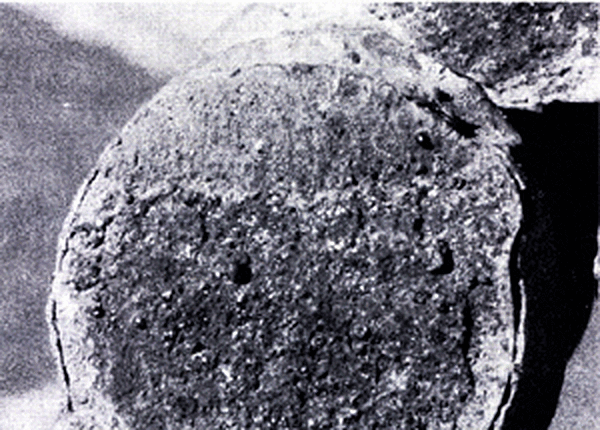Embrittlement of Bent Galvanized Steel
What should I say when my customer tells me galvanizing caused his bent steel to embrittle?
Galvanizing embrittlement is misleading. The embrittlement that has been termed as galvanizing embrittlement is more correctly a form of strain-age embrittlement. Strain-age embrittlement is defined as a change of properties of cold worked steel with time. These changes occur slowly at room temperature and more rapidly at higher temperatures. Accelerated embrittlement occurs when materials have been cold worked during fabrication and then galvanized. Bending is the most common form of cold working.

Strain-aging has received much attention in the galvanizing field because of its tendency for rapid aging of materials at the galvanizing temperature. This causes a loss of ductility, which frequently results in a brittle fracture during the ordinary process of handling and erection. It is vital for the fabricator to avoid this type of failure through changes in the engineering design, hot forming, heat treatment after fabrication, and or the selection of steels less susceptible to this failure.
The process of punching or bending circumpresses and distorts the metal around the circumference of the hole or bend. This generally starts slight tears or cracks in the material. The possible cause of embrittlement is the penetration of the zinc into the steel, particularly at these cracks and tears in the bed or near the punch holes. This penetration is shown in Figure 1. Deep penetration occurred mostly along the longitudinal axis of the bend.
The effect of thickness of the work is important because cold working becomes greater for given bending radius as the section gets thicker. The maximum bending radius possible should be used. A bending radius three times the thickness will ordinarily ensure a satisfactory galvanized product for steel with normal composition, i.e. a carbon content between 0.20 and 0.25 percent. If design specifications require sharp bends on heavy material, aluminum-killed steel or other non-aging steels should be specified.
Reinforcing bars are the most commonly bent steels ASTM A767 Standard Specification for Zinc-Coated Steel Bars for Concrete Reinforcement specifies the standard for bend diameters of reinforcing bars. IF bars are bent prior to galvanizing, they need to be fabricated to a bend diameter equal to or greater to that in Table 1. The material may be bent tighter than allowed in Table 1 (below) if it is stress relieved at a temperature of 900 to 1050 F for one hour for each inch of bar diameter.
When galvanizing is performed before bending, some cracking and flaking of the coating in the bend area may occur. This is not cause for rejection. Damage to the coated area should be repaired in accordance with ASTM A780. Some techniques are recommended to alleviate embrittlement in staring age sensitive steels.
- Use as large as bend radii as possible, at least 3 times the thickness
- Hot bend the steel for radii less than 4 times the section thickness
- Anneal at 1200 to 1500 degrees prior to galvanizing for radii less than 3 times the section thickness
- Ream punched holes to minimize cold working in pensive steels
| Bar No. | Grade 40 | Grade 50 | Grade 60 | Grade 70 |
|---|---|---|---|---|
| 3, 4, 6 | 6d | 6d | 6d | -- |
| 6 | 6d | 6d | 6d | 6d |
| 7, 8 | 6d | 6d | 6d | 6d |
| 9, 10 | 8d | 8d | 8d | 8d |
| 11 | 8d | 8d | 8d | 8d |
| 14, 18 | -- | -- | 10d | 10d |
© 2025 American Galvanizers Association. The material provided herein has been developed to provide accurate and authoritative information about after-fabrication hot-dip galvanized steel. This material provides general information only and is not intended as a substitute for competent professional examination and verification as to suitability and applicability. The information provided herein is not intended as a representation or warranty on the part of the AGA. Anyone making use of this information assumes all liability arising from such use.

